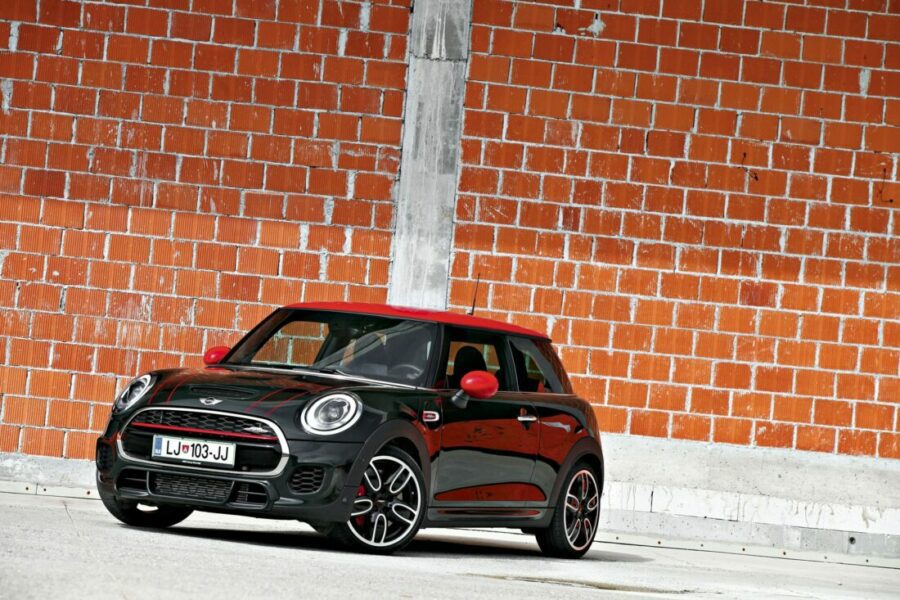
Test grilles: Mini John Cooper Works
It's been an almost perfect week written all over my skin. I first turned in the Renault Clio RS Trophy in a bit of a bad mood, and then a day later I calmed down by accepting the Mini John Cooper Works and immediately took it to Raceland. To get to know each other. The Mini JCW is the only Mini equipped with a XNUMX-litre petrol turbo engine.
The power is huge, as the data decorates as many as 231 "horses", and in the test we got, interestingly, a version with an automatic six-speed gearbox. Don't panic, this is not as serious as it might seem at first glance. The gearbox can also be controlled manually via useful lugs on the steering wheel or using the gear lever, which of course has a racing gear circuit. In the Green driving program, the transmission is very gentle in automatic mode, in the Mid program it is more daring, and in the Sport program it increases the engine speed all the way to the red field. That there will be no misunderstandings: it works so quickly and smoothly that I did not particularly miss either the manual transmission or the twin-plate clutch.
If you're not exactly a fan of right hand exercises, just consider this gadget for almost two thousand extra, because the Mini is still a city car. And if BMW or Mini like to brag that the Mini is a premium car, I can attest to that in good conscience. The infotainment system is top notch as we were spoiled with a projection screen, Harman Kardon speakers, helpful navigation and even Slovenian language on the menu. All the innovations that the new Mini has received are, of course, a plus for the most powerful John Cooper Works. The speedometer and tachometer are conveniently placed in front of the driver, while the navigation and other infotainment systems have been moved to a large center display that is still round for the benefit of the story.
The only downside to the interior was the colorful lighting as the Mini JCW changes color around the center screen. Almost too vulgar for my ideas, but I admit the possibility of aging. But, apparently, I have not yet outgrown the joy of the opportunity to try out a pocket car, since we usually translate the familiar English phrase "pocket rocket". I reached the 15th time with the Clio Trophy on Raceland, and heck, I didn't go over that time with the Mini. Then comes the disappointment as the Mini was everywhere, just not in the direction of the trail.
A look at the tires revealed a secret: while the Clio RS Trophy was fitted with Michelin Pilot Super Sport tires, the Mini was fitted with Pirelli P7 Cinturato tires. I apologize? The sportiest Mini was fitted with low fuel consumption touring tires. As a result, the Mini reached 49th place and lagged far behind its predecessor, which is still in 17th place. Yes, you are right, even the predecessor had the right footwear for such a powerful athlete, as he was 01 seconds faster with the Dunlop SP Sport 1,3 tires. The fact is that even the Jamaican athlete Usain Bolt will not break track records in slippers. right? The only consolation in this story is that the Mini JCW was XNUMX liters more fuel efficient on our standard lap, which can also be attributed to the tires.
Both, however, consume over ten liters, easily even 11 with a heavy right leg. The Electronic Partial Differential Lock also works when the ESC is off and we didn't fully use the Brembo brakes due to the poorer tires. Interestingly, Mini JCW has classic lines up to 200 kilometers per hour, and from 200 to 260 you are replaced by a checkered flag. Fine. I couldn't resist a crack in the exhaust pipe, although the driving program had to be changed over and over to Sport. Then you bow to the car, enjoy the ride immensely, and forget about a small trunk, a colorful dashboard, or almost again a higher purchase price than your competitors.
text: Alyosha Mrak photo: Sasha Kapetanovich
Mini Mini John Cooper Works
Basic data
| Base model price: | 24.650 € |
|---|---|
| Test model cost: | 43.946 € |
| Power: | 170kW (231 KM) |
| Acceleration (0-100 km / h): | 6,5 with |
| Maximum speed: | 246 km / h |
| Mixed flow ECE: | 5,9l / 100km |
Cost (up to 100.000 km or five years)
Technical information
| engine: | 4-cylinder, 4-stroke, in-line, turbocharged, displacement 1.998 cm3, maximum power 170 kW (231 hp) at 5.200–6.000 rpm – maximum torque 320 Nm at 1.250–4.800 rpm. |
|---|---|
| Energy transfer: | front wheel drive engine - 6-speed automatic transmission - tires 205/40 R 18 W (Pirelli P7 Cinturato). |
| Capacity: | 246 km/h top speed - 0-100 km/h acceleration in 6,1 s - fuel consumption (ECE) 7,2/4,9/5,7 l/100 km, CO2 emissions 133 g/km. |
| Mass: | empty vehicle 1.290 kg - permissible gross weight 1.740 kg. |
| External dimensions: | length 3.850 mm - width 1.727 mm - height 1.414 mm - wheelbase 2.495 mm |
| Box: | trunk 211–731 l – 44 l fuel tank. |
Our measurements
| Measurement conditions: T = 20 ° C / p = 1.033 mbar / rel. vl. = 54% / odometer status: 4.084 km | |
| Acceleration 0-100km: | 6,5s |
|---|---|
| 402m from the city: | 14,6 s ( 163 km / h) |
| Braking distance at 100 km / h: | 38,1m |
| AM table: | 39m |
